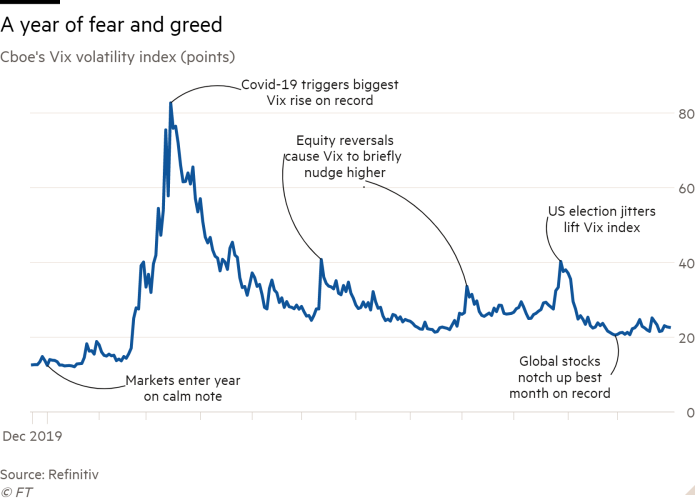Investors wager on lower volatility this year after 2020 turmoil

Roula Khalaf, Editor of the FT, selects her favourite stories in this weekly newsletter.
Volatility itself went on a wild ride in 2020, veering from near-perfect calm at the beginning of the year to full-blown panic in March, before central bank stimulus knocked stock market turbulence back to near the long-term average by December. Analysts expect 2021 to be more tranquil, setting investors up to tiptoe back into the risky yet lucrative “short-vol” trade.
The Vix volatility index — popularly nicknamed the “fear gauge” as it reflects the ebb and flow of Wall Street’s anxiety levels — entered last year around the 12 to 13 points level, close to record lows, as investors anticipated a continuation of the longest bull run in history.
The calm began to fade in February, and shattered decisively in March when the pandemic forced the shutdown of swaths of the global economy. The Vix index, which measures the short-term expected volatility of the S&P 500 index from derivatives prices, soared to a peak of over 85 points in mid-March.
However, the extraordinarily aggressive measures taken by central banks and governments to buttress financial markets sent the Vix index sliding back again.
Unnerving but ultimately fleeting stock market reversals in June and September caused brief rises in the Cboe’s volatility index, and nervousness over the looming US presidential election caused the “fear gauge” to climb higher at the end of October. But the stock market rally stayed on track, and the Vix finished the year at just shy of 23 points.

That has reopened the door to investors that aim to profit from “shorting” volatility, in practice selling insurance against stock market squalls and pocketing the premiums that other investors pay.
Many volatility-sellers took a beating in March and have withdrawn from the market, which analysts say has made the attractiveness and payout of short-vol trades more attractive. “The backdrop remains supportive for vol sellers,” Morgan Stanley analysts said in a recent note.
Marko Kolanovic, global head of quantitative strategy at JPMorgan, argues that the Vix has historically in the long run been driven by monetary policy, with an 18-month lag. In light of the stimulus unleashed since March — globally, central banks have bought $7.5tn of bonds this year, according to the IMF — Mr Kolanovic expects the Vix index to remain somnolent.

“Given the significant increase of monetary accommodation nine months ago, we expect it to pressure volatility for most of 2021,” he wrote in a recent note to clients. JPMorgan expects the Vix to average just 17 points this year, compared with its long run average of about 20, as more return-hungry investors begin to sell insurance against renewed turbulence.
“Given that volatility selling suffered large losses in March, most volatility sellers reduced exposure or entirely stepped out of the market in 2020,” Mr Kolanovic said. “In 2021, we expect these sellers to gradually step back in, attracted by wide risk premia, declining volatility-of-volatility and significant opportunities to generate returns in an otherwise low yield environment.”
There are already indications that the short-vol trade is coming back in vogue. The US Commodity Futures Trading Commission collects data on the positioning of various types of traders, and its data indicate that “non-commercial” actors — a proxy for hedge funds — are now net short over 90,000 Vix futures contracts.
Comments